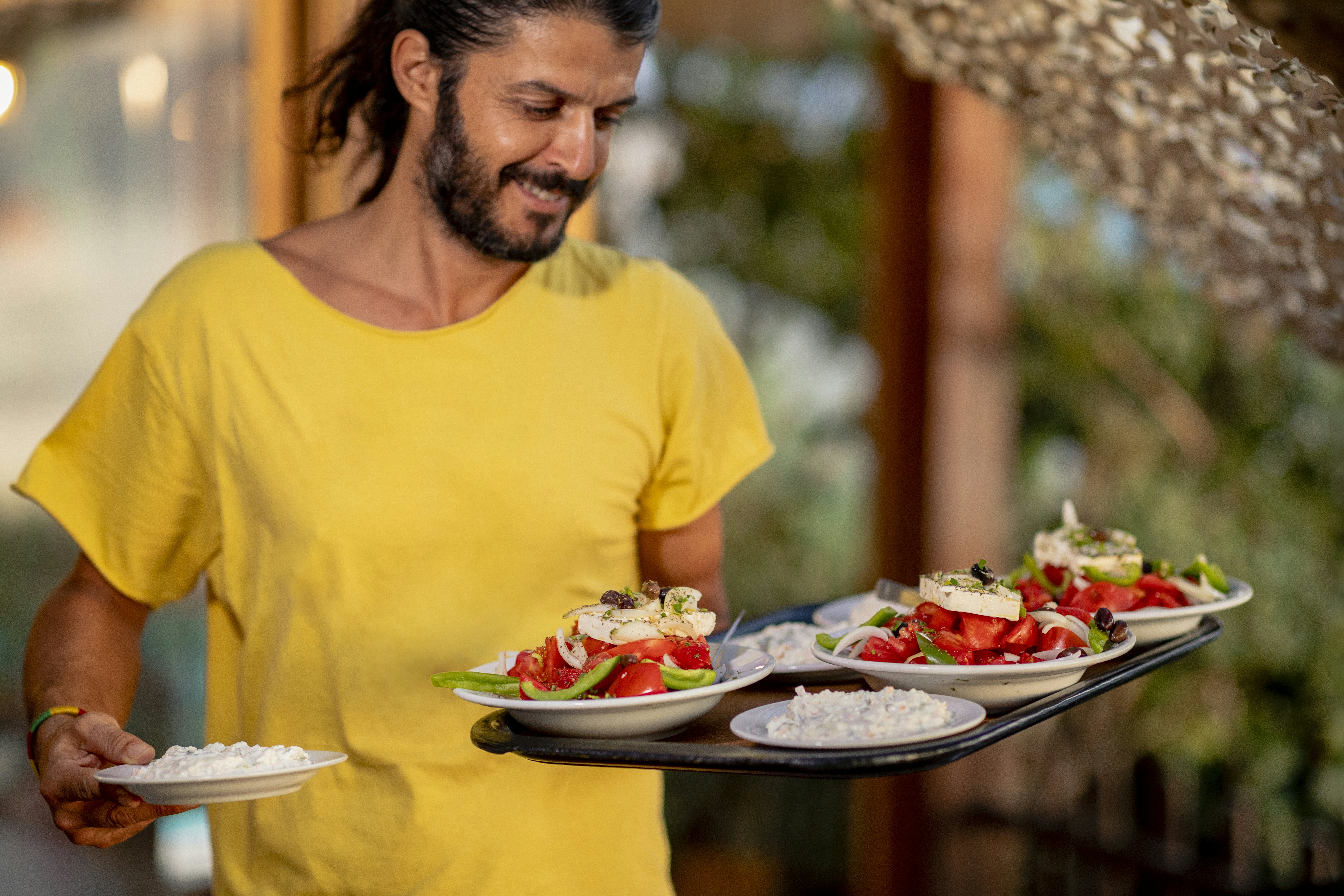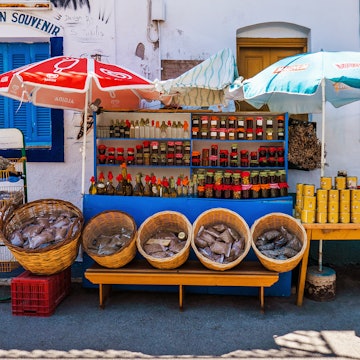
Food is culture on Greece’s Northern Aegean Islands
Sponsored by
Jul 12, 2023 • 5 min read

Discover the islands of Greece's Northern Aegean, their local fare, distinct culinary delights, traditional, homey recipes, and proud and welcoming people © Malcolm P Chapman / Getty Images
Greek food is widely celebrated around the world, but in reality there is no such thing as a single Greek cuisine. Each region has its own distinct tastes and recipes shaped over the centuries by the regional traditions, the local produce, and the area’s cultural influences.
The islands of the Northern Aegean, untouched by mass tourism, have their own culinary history, recipes, and ingredients, as well as natural beauty and a cultural legacy on par with the country’s most glorious corners. Come discover these islands, their local fare, distinct culinary delights, traditional, homey recipes, and proud and welcoming people. You just might find yourself at home in the local tavernas and restaurants.

From the land
The fertile soil of the islands of the Northern Aegean produces top-quality agricultural products for both Greece and abroad, as demand for their quality and flavor is on the rise around the world.
Olive oil, the king of Greek staples, is particularly abundant in Lesvos, where more than 10 million olive trees are cultivated using mild traditional methods. The region is known for producing fine quality extra virgin olive oil, a Protected Designation of Origin (PDO) product that ranks among the most flavorful in the country. Excellent varieties of olives, including the famous and delicious Thasos throubes, are also produced in the region.

Each island in the Northern Aegean also has its own local varieties of feta cheese, as well as an array of locally and exclusively produced cheeses such as Ladotyri (Lesvos), Kalathaki (Limnos), Kathoura (Ikaria), and Armogalo (Samos).
Finally, beekeeping is one of the leading agricultural activities on these islands, where fragrant wild herbs like thyme and erica, along with pine and chestnut forests, contribute to the production of honey considered some of the best in the world.

Wild catch
Fresh seafood is, expectedly, a fundamental part of the islanders’ diet and a significant source of income for many of the smaller islands in the region. Small fish varieties, particularly Kalloni sardines, are exclusive to the area and are highly appreciated. In any fish taverna of the region, expect to be served the morning catch at prices unheard of in other crowded tourist destinations.
Fresh fish may be the quintessential Mediterranean treat, but the mountainous terrain of the larger islands provides an ideal environment for free-range, and often feral, goats and sheep. Naturally, their super tasty and healthy meat is an essential part of the local fare. Particularly on Samothraki, Samos, and Ikaria, kid and lamb meat is favored over fish and is cooked with various mouth-watering local recipes.

The local treatments
The cuisine of the North Aegean Islands’ uses locally grown products – often from small family farms or home plots. Fruits and vegetables are used when they’re in season, making for a more flavorful and wholesome savory experience and requiring less intensive cultivation.
Each of the islands has special recipes based on local customs, available ingredients, and time of year, often cooked using traditional methods such as wood-fired ovens. Pies made with aromatic herbs and greens are a common feature, with handmade dough being used in most cases, and jams and spoon sweets are among the specialties of the region.

Ikaria’s sofiko is a scrumptious seasonal vegetable stew. Its vibrant flavors and fresh ingredients make it delightful during the warm months. On the island of Chios, small fennel pies with fish roe (malathropites) are a favorite local delicacy and a special culinary experience.
On the other hand, Limnos is renowned for its flomaria, homemade pasta noodles crafted by hand with great expertise. Thasos delights in stuffed zucchini blossoms, a delicate blend of textures and tastes. In Samos, succulent stuffed lamb cooked in the oven and flavorful chickpea patties are favorites. Finally, on Samothraki, the island’s specialty is kid slowly roasted on a spit, creating an unforgettable dining experience.

From the bottle
Of course, it wouldn’t be Greek cuisine without wine. Many large wineries are open to the public, offering the opportunity to discover the ancient art of winemaking. But smaller-scale production is also quite common, with many families producing their own house wines of often exceptional quality.
Limnos produces the famous and delicious Muscat of Alexandria variety, while Samos boasts more than 4,000 acres of vineyards and is renowned for its excellent sweet wines – the first in Greece to receive a PDO designation – which are exported worldwide.

In addition to wines, the North Aegean region is known for its distinct spirits, with ouzo being the most iconic. The strong, anise-flavored liquor is served with water and ice and enjoyed with seafood. Lesvos is the major ouzo-producing region, with dozens of distilleries scattered around the island, but the other islands have their own local productions of ouzo and also tsipouro, a ‘cousin’ spirit distilled from grape pomace, with or without anise addition.
In Chios, make sure to try Masticha, the delicious, sweet, and aromatic liquor produced exclusively on the island.

It’s not only about food
In terms of culinary conventions, the joy of dinning in Greece is inextricably linked to traditional social rituals, religious festivals, and celebrations.
Every summer and throughout the year, each village organizes a large feast (panigiri) in honor of its patron saint. Locals gather at the square and, under centuries-old plane trees, enjoy local specialties accompanied by live traditional music and dancing throughout the night.
Small impromptu celebrations are also common, often held around a family table or in local tavernas, particularly in August when the villages are filled with holidaymakers from the cities and extended families come together.

Tasteful mementos
A common feature of the islands is local workshops and women’s cooperatives focusing on producing and selling packaged traditional food products. Visitors can sample and buy delectable handmade spoon sweets such as sour cherry, watermelon, cherry, zucchini, quince, apple, grape, and fig. Almond and walnut delicacies, biscuits, rusks, and preserves are also available.
Homemade liqueurs with flavors such as apricot, sour cherry, mint, mandarin, mastic, bitter almond, and pomegranate make perfect gifts, while herbs, fragrant plants, olives, pickles, vine leaves, wheat pastries, and traditional cheese are perfect culinary ‘souvenirs’ to take home.
Folk art also thrives at cooperatives and workshops, including exquisite needlework, woven goods, handcrafted worry beads, and wooden crafts.
These are unique objects – small pieces of Greece you can bring home along with the cherished memories you will certainly carry in your mind and heart.
Sponsored by Greek National Tourism Organisation
As a travel entertainment and inspirational media outlet, we sometimes incorporate brand sponsors into our efforts. This activity is clearly labeled across our platforms.
This story was crafted collaboratively between Greek National Tourism Organisation and Lonely Planet. Both parties provided research and curated content to produce this story. We disclose when information isn’t ours.
With sponsored content, both Lonely Planet and our brand partners have specific responsibilities:
-
Brand partner
Determines the concept, provides briefing, research material, and may provide feedback.
-
Lonely Planet
We provide expertise, firsthand insights, and verify with third-party sources when needed.












